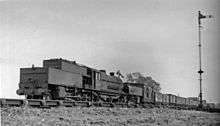LMS Garratt
 | |||||||||||||||||||||||||||||||||||||||||||||||
| |||||||||||||||||||||||||||||||||||||||||||||||
| |||||||||||||||||||||||||||||||||||||||||||||||
| |||||||||||||||||||||||||||||||||||||||||||||||
| |||||||||||||||||||||||||||||||||||||||||||||||
The London Midland and Scottish Railway (LMS) Garratt was a class of Garratt 2-6-0+0-6-2 steam locomotive designed for heavy freight. A total of 33 were built from 1927, making them the most numerous class of Garratt in Britain.
Overview
After Grouping the LMS continued the Midland Railway's "small engine policy" of hauling trains using two or three locomotives of moderate power coupled together. This led to most of the Toton (Nottinghamshire)-Brent (London) coal trains being double-headed by 0-6-0 locomotives. It was realised that double heading was uneconomical so a Garratt locomotive was ordered from Beyer, Peacock and Company. However the LMS Derby design office insisted on the fitting of their standard axleboxes to the design. These axleboxes were barely adequate for the LMS Class 4F 0-6-0 locomotives, on which they frequently overheated, and were a major weakness on the LMS Garratts. They were also always heavy on coal and maintenance.

Three locomotives were built in April 1927 and the remaining 30 were built in the period August to November 1930. All were built with straight sided bunkers but from 1931 all except the first two of the 1927 trio were fitted with revolving coal bunkers. These were conical in shape and were revolved and oscillated by means of a small 2-cylinder steam engine. The revolving bunkers prevented coal dust from entering the cab and the oscillation facility made them self-trimming.
The 1927 trio were numbered 4997–4999, and the 1930 batch from 4967 to 4996. They were later renumbered 7967–7999 in the same order to make way for the new Black 5’s . British Railways added 40000 to their numbers.

The roundhouses at Toton MPD had to have extra length Garratt roads to accommodate them. Mostly used for heavy coal trains, they later found other uses as well. Others were allocated to Wellingborough (depot code 45A where 15 locomotives were located in the 1950s) and Hasland near Chesterfield. Trains for Manchester were generally routed along the Hope Valley Line and the Garratts normally came off their trains at the Gowhole freight sidings just south of Chinley. A few would work the Ambergate to Pye Bridge Line using the north curve at Ambergate, but only as far as Rowsley, where the train would be split. This was normal for goods trains because of the danger of couplings breaking on the climb to Peak Forest. In addition, although they had ample tractive effort to climb the gradient, in the days before goods wagon trains had continuous brakes there were problems on the way down into Chinley. On an early attempt, the loco was inspected at Heaton Mersey and it was found that all of its brake blocks had melted.[1]
The class was withdrawn between June 1955 and April 1958. None have survived into preservation.
| Year | Quantity in service at start of year | Quantity withdrawn | Locomotive numbers |
|---|---|---|---|
| 1955 | 33 | 7 | 47970/75/85/89–91/93. |
| 1956 | 26 | 13 | 47971/74/76/77/81/83/84/88/92/96–99. |
| 1957 | 13 | 12 | 47967–69/72/73/78–80/82/86/87/95. |
| 1958 | 1 | 1 | 47994. |
Models
The Rosebud Kitmaster company produced an unpowered polystyrene injection moulded 00 scale model, which went on sale in March 1961. In late 1962, the Kitmaster brand was sold by its parent company (Rosebud Dolls) to Airfix, who transferred the moulding tools to their own factory; they re-introduced some of the former Kitmaster range, but the Garratt model was not among them. The moulding tools for this locomotive were scrapped in 1982.[2] Heljan has been commissioned by Hattons to produce a model in OO gauge. This will be Heljan's first UK outline OO gauge steam locomotive model.[3]
References
- ↑ Bentley, C., (1997) British Railways Operating History: Volume one, The Peak District, Carnarvon: XPress Publishing.
- ↑ Knight 1999, pp. 7,9,41,46,66.
- ↑ Hattons
- Bentley, C. (1997). British Railways Operating History: Volume one, The Peak District. Carnarvon: XPress Publishing.
- Essery, Bob; Toms, G. (1998). LMS & LNER Garratts. Wild Swan Publications. ISBN 0-906867-93-2.
- Knight, Stephen (1999). Let's Stick Together: An Appreciation of Kitmaster and Airfix Railway Kits. Clopthill: Irwell Press. pp. 7,9,41,46,66. ISBN 1-871608-90-2.
- Longworth, Hugh. British Railway Steam Locomotives 1948-1968. Oxford Publishing Company. ISBN 0-86093-593-0.
- Pixton, B. (2000). North Midland: Portrait of a Famous Route. Cheltenham: Runpast Publishing.
External links
| Wikimedia Commons has media related to LMS Garratts. |